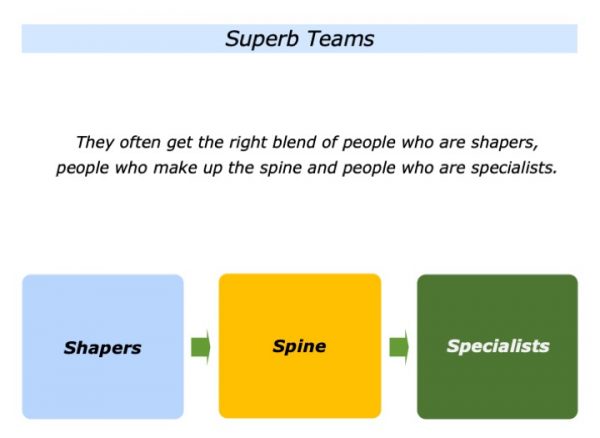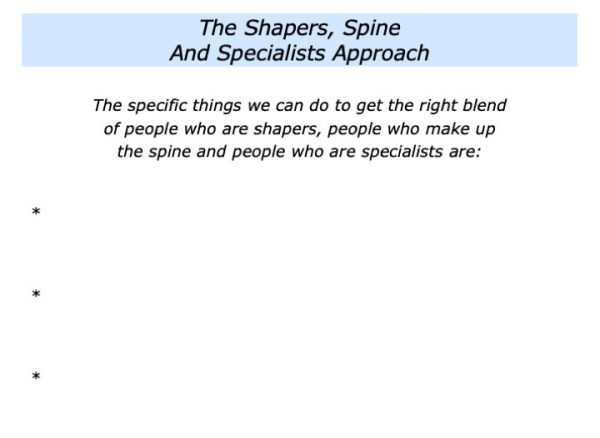
There are many models for building superb teams. You may start by making sure you have people who embody the team’s spirit and have certain strengths.
The next step is to get the right blend of people who are shapers, who make up the spine and who are specialists. You can then coordinate their strengths to achieve success. Let’s explore these themes.
Shapers
Great teams have people who are shapers. These may be strong personalities who are good at making strategic decisions and setting the team’s direction. They aim to ensure that people keep focusing on the team’s purpose, principles and picture of success.
Such individuals may also act as positive models when shaping the team’s culture. People watch how these individuals behave and see this as ‘the way we do things around here’.
Shapers often need to play to their strengths and, when appropriate, have colleagues who compensate for any weaknesses. Many leaders, for example, build a leadership team that covers the areas necessary for helping their people to achieve success.
Spine
Great teams have people who make up the spine. Such individuals are often superb workers who deliver consistently high professional high standards.
Many leaders recognise that they rely on people in the spine to translate the team’s strategies into action. The quality of the work done by people in the spine often determines the quality of work done by the team.
Great teams encourage people in the spine. These people are good at implementing strategies, but it is important to give them some ownership of how to achieve the goals. Teams that take their spine for granted do so at their peril.
Specialists
Great teams make good use of specialists. Such people need to embody the spirit of the team and also provide specialist skills in their areas of expertise.
Leader often manage by outcomes when harnessing the talents of specialists. They start by giving people the context. They explain the team’s purpose, principles and picture of success.
Bearing in mind the person’s strengths, they make clear contracts about each specialist’s best contribution. They then encourage and enable them to do superb work on the way towards achieving the team’s goals.
The Role Of Shapers And People
In The Spine Sometimes Changes
The role that a person plays can sometimes shift depending on their responsibilities. The CEO of the European arm of a US company, for example, will act as a shaper for their people in Europe. The US head office, however, may see them as part of the spine.
A Department Head may be seen as part of the spine. They will act as a shaper, however, for the people in their team. They will have a strong influence on the culture of the team.
Let’s return to your own work. Imagine that you are the leader for the team that you work in at the moment. Imagine also that you aim to make sure that you have the right blend of people in the team. If you wish, try exploring the following themes.
The Shapers
Great teams frequently have two or three people at the centre who shape the overall direction. They may involve other key people, however, to ensure that such individuals have a real sense of ownership in terms of setting and implementing the strategy.
Some teams limit themselves to a relatively small number of shapers who set the strategic direction and ensure there is alignment. This is because having many people who consider themselves to be strategic shapers can lead to some individuals pursuing their own agendas.
Great teams involve their people in helping to build the strategy but they do this within certain parameters. They make sure that everybody is committed to focus on the team’s purpose, principles and picture of success.
Let’s return to your team. Who are the shapers you already have in the team? What are their individual and collective strengths? What do they do well? How can they do more of these things? What can they maybe do better in the future and how?
Looking ahead, will you at any point need more shapers in the team? If so, how can develop or add more shapers? What are the steps you can take to make this happen?
The Spine
Looking at your team, who are the people who make up the spine? These are the people who translate the strategies into action and deliver consistently high standards.
Such people are vital. They may sometimes be taken for granted, however, so it is important to keep close to them. You can provide them with the required support and also give them the opportunity to develop.
Bearing this in mind, how can you encourage such people? How can you spend quality time with them? How can you ensure they have the support needed to do the job? How can you help them to keep developing?
Such people are often duty driven. Whilst they are prepared to implement the strategies, it is important to give them a sense of ownership in how to make things work properly.
As mentioned earlier, ignore such people at your peril. They are the people who make things work. The last thing you want is for them to walk out of the door.
It is vital to give these people support. Bearing this in mind, keep in touch with them. It can be useful to invite them to describe their views on the following themes.
a) The specific things they think are going well;
b) The specific things they think can be done better and how;
c) The specific support they need to be able to do their jobs well;
d) The specific ways they would like to develop as professionals.
You can follow up by providing this support and helping them to continue to develop.
The Specialists
Who are the specialists in your team? These are people who have specialist skills and the ability to contribute towards achieving the team’s picture of success.
Such people may have specific job titles. They may be knowledge workers or individual contributors. They may be full-time workers, part-time workers or people you hire to do specialist work.
As mentioned earlier, harnessing their specialist skills often calls for managing by outcomes. Bearing in mind the person’s strengths, it is important to make clear contracts with the specialist in the following areas.
The What
The specific results you would like the person to deliver towards achieving the team’s goals. It is vital to agree on these outcomes.
The How
The specific strategies you would like the person to follow – and the support they need – to achieve the goals. It is also important, however, to give the specialist freedom – within certain parameters – regarding how they use their strengths to deliver the results.
The When
The specific things the person will deliver and by when. Also agree with the specialist about how they will proactively keep others informed about their progress toward achieving the goals.
The Shapers, Spine And
Specialists – The Action Plan
It is now time to translate your ideas into action. Bearing this in mind, it can be worth exploring the following themes.
What can you do to ensure the shapers play to their strengths? How can you compensate for any of their weaknesses? How can you make sure that each of them make their best contributions to the team?
What can you do to care for the people in the spine? How can you support and encourage them? How can you clarify what they think is going well and what can be done better? How can you clarify how they want to develop as professionals?
What can you do to harness the skills of the specialists? How can you make clear contracts about their best contributions? How can you keep focusing on the outcomes they are to deliver and enable them to do superb work?
What are the kinds of decisions you may need to take regarding the kinds of specialist skills the team may need in the future? How can you be proactive in taking these steps?
Let’s bring this all together. What are the actions you need to take to get the right blend of shapers, people in the spine and specialists? How can you translate these ideas into action? What will be the benefits of taking these steps?
There are many ways to build teams. This section has looked at one approach. If you wish, try tackling the exercise on this theme. This invites you to complete the following sentences.







Leave a Reply